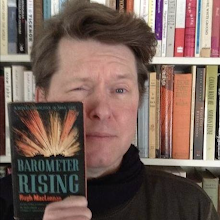The Further Adventures of Jimmie Dale
Frank L. Packard
New York: Doubleday, Doran, 1931
"The Gray Seal is dead."
So ends The Adventures of Jimmie Dale. I enjoyed reading those words, even if I knew they weren't true; Packard published four more Jimmie Dale books, The Further Adventures of Jimmie Dale being the second.
I do like a happy ending.
Slowly, very slowly, veils are cast aside, until the mystery woman is revealed as Marie LaSalle, a beautiful heiress who has been living amongst the dregs of society disguised a hag known as Silver Mag. In the novel's climactic scene, both Jimmie and Marie shed their respective secret identities when the Crime Club, the group that had caused absolutely sweet Marie to go into hiding, is destroyed. Witnesses are convinced that Silver Mag and the Gray Seal perished in an inferno.
As I say, I do like a happy ending.
I picked up The Further Adventures of Jimmie Dale because I was curious to see how Jimmie and Marie were getting along. I expected them to be married, living lives of luxury in a Park Avenue penthouse, and solving crimes for kicks like Nick and Nora Charles (only without the drinking or the humour). My heart fell when I learned that Jimmie and Marie weren't together. There was no break-up. Ever cautious Marie decides that surviving members of the Crime Club might be suspicious of their relationship; after all, she and Jimmie hadn't known each other before the troubles started. She determines that the best course of action is to stay away from one another for a year or so.
And then Marie disappears.
She was crouched in the bottom of the boat close beside him. He bent his head until his lips touched her hair, and lower still until his lips touched hers. And a long time passed. And the boat drifted on. And he drew her closer into his arms, and held her there. She was safe now, safe for always – and the road of fear lay behind. And into the night there seemed to come a great quiet, and a great joy, and a great thankfulness, and a wondrous peace.And so, another happy ending. But will they be borne back ceaselessly into the past?
And the boat drifted on.
And neither spoke – for they were going home.
Object: A 340-page book bound in bland, suitably grey boards. I bought my copy two years ago as part of the Gray Seal Edition of Packard's works. Price: US$25.00 for ten volumes. Are there more than ten? I'm assuming so, if only because The Adventures of Jimmie Dale doesn't figure amongst my ten.
Access: Serialized in People's magazine (November 1916 - August 1917), The Further Adventures of Jimmy Dale first appeared as a book in 1919, published by Copp, Clark (Canada), Doran (the United States) and Cassell (the United Kingdom). It sold well in its day – the Hodder & Stoughton edition enjoyed at least ten printings! – and yet a mere eighteen copies are currently listed for sale online. The cheapest is a crappy A.L. Burt reprint with jacket pasted inside. Price: US$6.00. The best comes from a St Catharines bookseller, who offers a sad Copp, Clark first: "Only about 80% of the dust jacket remains. The spine is completely gone." Price: US$25.00. Not one copy of the Gray Seal Edition is listed.
The Further Adventures of Jimmie Dale enjoyed at least two translations: Spanish (El sello gris) and Czech (Šedá pečeť 2). I'd be surprised if there aren't more.
A few words about the Spanish cover: That grey seal is much too large. Jimmie always takes care to handle same using tweezers. I'm pretty certain the mask depicted is not made of silk.
Canadians looking to borrow The Further Adventures of Jimmie Dale from their local library are pretty much out of luck; only our universities and the Bibliothèque et Archives nationales du Québec have copies.
It can be read here – gratis – thanks to the Internet Archive.
Related post:
























































